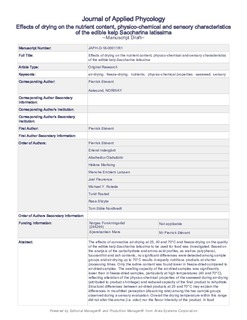| dc.contributor.author | Stévant, Pierrick Francois Denis | |
| dc.contributor.author | Indergård, Erlend | |
| dc.contributor.author | Ólafsdóttir, Aðalheiður | |
| dc.contributor.author | Marfaing, Hélène | |
| dc.contributor.author | Larssen, Wenche Merete Emblem | |
| dc.contributor.author | Fleurence, Joël | |
| dc.contributor.author | Roleda, Michael | |
| dc.contributor.author | Rustad, Turid | |
| dc.contributor.author | Slizyte, Rasa | |
| dc.contributor.author | Nordtvedt, Tom Ståle | |
| dc.date.accessioned | 2018-04-26T12:10:43Z | |
| dc.date.available | 2018-04-26T12:10:43Z | |
| dc.date.copyright | | |
| dc.date.copyright | | |
| dc.date.created | 2018-04-11T14:42:48Z | |
| dc.date.issued | 2018-03-23 | |
| dc.identifier.issn | 0921-8971 | |
| dc.identifier.uri | http://hdl.handle.net/11250/2496150 | |
| dc.description.abstract | The effects of convective air-drying at 25, 40, and 70 °C and freeze-drying on the quality of the edible kelp Saccharina latissima to be used for food were investigated. Based on the analysis of the carbohydrate and amino acid profiles, as well as polyphenol, fucoxanthin, and ash contents, no significant differences were detected among sample groups, and air-drying up to 70 °C results in equally nutritious products at shorter processing times. Only the iodine content was found lower in freeze-dried compared to air-dried samples. The swelling capacity of the air-dried samples was significantly lower than in freeze-dried samples, particularly at high temperatures (40 and 70 °C), reflecting alteration of the physico-chemical properties of the seaweed during air-drying (attributed to product shrinkage) and reduced capacity of the final product to rehydrate. Structural differences between air-dried products at 25 and 70 °C may explain the differences in mouthfeel perception (dissolving rate) among the two sample groups observed during a sensory evaluation. Overall, the drying temperature within this range did not alter neither the aroma (i.e. odor) nor the flavor intensity of the product. In food applications where the product’s mechanical properties (e.g. porosity) are essential, freeze-drying, and to a lesser extent, air-drying at low temperatures, will result in higher quality products than air-drying at higher temperatures. | nb_NO |
| dc.language.iso | eng | nb_NO |
| dc.rights | Attribution-NonCommercial-NoDerivatives 4.0 Internasjonal | * |
| dc.rights.uri | http://creativecommons.org/licenses/by-nc-nd/4.0/deed.no | * |
| dc.subject | Air-drying | nb_NO |
| dc.subject | Freeze-drying | nb_NO |
| dc.subject | Nutrients | nb_NO |
| dc.subject | Physico-chemical properties | nb_NO |
| dc.subject | Seaweed | nb_NO |
| dc.subject | Sensory | nb_NO |
| dc.title | Effects of drying on the nutrient content and physico-chemical and sensory characteristics of the edible kelp Saccharina latissima | nb_NO |
| dc.type | Journal article | nb_NO |
| dc.type | Peer reviewed | nb_NO |
| dc.description.version | acceptedVersion | nb_NO |
| dc.rights.holder | © Springer Science+Business Media B.V., part of Springer Nature 2018 - Accepted manuscript © the author(s) 2018 | |
| dc.source.journal | Journal of Applied Phycology | nb_NO |
| dc.identifier.doi | 10.1007/s10811-018-1451-0 | |
| dc.identifier.cristin | 1578831 | |
| cristin.unitcode | 7566,5,0,0 | |
| cristin.unitname | Prosessteknologi | |
| cristin.ispublished | true | |
| cristin.fulltext | postprint | |
| cristin.qualitycode | 1 | |

